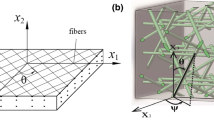Summary
The spectral decomposition of the compliance and the stiffness tensors for a transversely isotropic body (fiber-reinforced composite), and their eigenvalues derived from, define in a simple and efficient way the respective elastic eigenstates of loading of the material. It has been shown that, for the general orthotropic or transversely isotropic body, these eigenstates consist of two double components σ1 and σ2, which are shears, with σ2 a simple shear, and σ1 a suprposition of simple and pure shears, and they are associated with distortional components of energy. The remaining two eigenstates, with stress components σ3 and σ4 are the orthogonal supplement to the shear subspace of σ1 and σ2, and consist of an equilateral stressing in the plane of isotropy, superimposed with a prescribed tension or compression along the symmetry axis of the material.
In this paper a particular class of transversely isotropic materials is studied, whose mechanical properties are conveniently selected to reduce the two last eigenstate components in such a manner, that the one is identified to contribute only a dilatational type of strain energy, whereas the other a distortional one. In this way the four eigenstates are clearly separated in two distinct groups creating either distortional or dilatational types of strain energy. It was shown that this family of materials behave like the isotropic body, in spite of their differences in the elastic constants along their principal axes of anisotropy.
Since with fiber-composites it is possible to arrange their mechanical properties by selecting the appropriate ratios between matrix and inclusions, according to their properties, this possibility of selecting in advance the properties of the composite is feasible. Taking into consideration that quasi-isotropic materials develop the smallest stress concentrations in the structures, the development and selection of such composites with quasi-elastic properties becomes very important.
Similar content being viewed by others
References
Nye, J. F.: Physical properties of crystals: their representation by tensors and matrices. Oxford: At the Clarendon Press 1957.
Srinivasan, T. P., Nigam, S. D.: Invariant elastic constants for crystals. J. Math. Mech.19 (5), 411–420 (1969).
Walpole, L. J.: Fourth-rank tensors of the thirty-two crystal classes: multiplication tables. Proc. Roy. Soc. LondonA391, 149–179 (1984).
Rychlewski, J.: On the Hooke's law. Prikl. Matem. i Mekh.48 (3), 303–314 (1984).
Rychlewski, J.: Elastic energy decompositions and limit criteria. Adv. Mechanics (Uspechi Mekhanikii)10 (3), 83–102 (1987).
Theocaris, P. S.: The compliance fourth-rank tensor for the transtropic material and its spectral decomposition. Proc. Natl. Acad. Athens64 (1), 80–100 (1989).
Theocaris, P. S.: The decomposition of the strain-energy density of a single-ply laminate to orthonormal components. J. Reinf. Plast. Comp.8 (6), 565–583 (1989).
Theocaris, P. S., Philippidis, T. P.: Elastic eigenstates of a medium with transverse isotropy. Arch. Mech. (Archiwum Mekh. Stosowanej)41 (5), 717–724 (1989).
Theocaris, P. S., Philippidis, T. P.: Variational bounds on the eigenvalue ω of transversely isotropic materials. Acta Mech.85 (1), 13–26 (1990).
Theocaris, P. S., Philippidis, T. P.: Spectral decomposition of compliance and stiffness fourth-rank tensors suitable for orthotropic materials. Z. Angew. Math. Mech.71 (3), 161–171 (1991).
Theocaris, P. S., Philippidis, T. P.: Stress distribution in orthotropic plates with coupled elastic properties. Acta Mech.80, 95–111 (1989).
Theocaris, P. S.: Failure criteria for weak-axis quasi-orthotropic woven-fabric composites. Acta Mech.95, 69–86 (1992).
Beltrami, E.: Sulle conditioni di resistenza dei corpi elastici. Opere Matematiche IV (1920). See also: Rendiconti del R. Instituto Lombardo di Scienze Lettere e Arti18, 704–714 (1885).
Haigh, R. P.: The strain energy function and the elastic limit. Engineering, CX, 158–160 (1920).
Blakslee, O. L., Proctor, D. C., Seldin, E. J., Spence, G. B., Weng, T.: Elastic constants of compression annealed pyrolytic graphite. J. Appl. Phys.41 (8), 3373–3382 (1970).
Blessing, G. V., Elban, W. L.: Aluminium matrix composite elasticity measured ultrasonically. J. Appl. Mech.48, 965–966 (1981).
Author information
Authors and Affiliations
Rights and permissions
About this article
Cite this article
Theocaris, P.S. On a family of quasi-isotropic fiber-reinforced composites. Acta Mechanica 96, 163–180 (1993). https://doi.org/10.1007/BF01340708
Received:
Issue Date:
DOI: https://doi.org/10.1007/BF01340708



